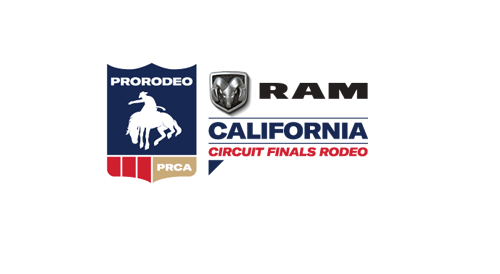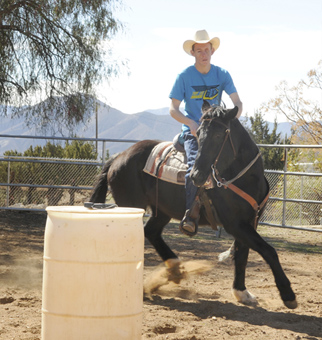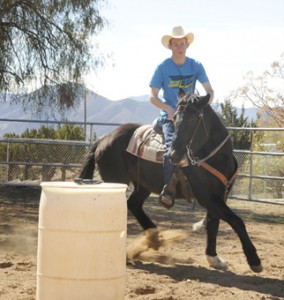Our young folks are the future of the PRCA and WPRA - They are the future of rodeo! Here is a very inspiring story about Taylor Howell, a member of the California High School Rodeo District 9 (website)!
Please support our young ropers and riders - The Cowboys and Cowgirls of the National High School Rodeo Association website and the California High School Rodeo Association website.
[info]This selection courtesy of the Antelope Valley Lifestyles Magazine and the Antelope Valley Press.[/info]
WRITTEN AND PHOTOGRAPHED BY Rich Breault
Seventeen-year-old Taylor Howell greeted his visitors and gave them a tour of his family’s Acton ranch. He nonchalantly strode down a steep embankment, stepping over a piece of wood in his way as he made his way toward the horses.
“This one here’s Annie. She’s my mom’s horse, but I ride barrels on her,” he said, pointing to the black quarter horse. He turned and walked to the next corral. “This one here is Bo. He’s a little slower.”
He introduced yet another horse he’s training to be his roping horse. His younger brothers — Dustin, 10, Dylan, 8, and Johnny, 4 — followed Taylor as he talked.
“Dustin, get off the fence,” Taylor said. Dustin, a couple of railings up on Bo’s corral fencing, jumped down quickly.
After walking back to the house to introduce his visitors to his mom and stepdad, Jennifer and Doug Oudekirk, Taylor headed back out, closing the sliding door behind him, to saddle Annie for a demonstration of their barrel racing skills.
A typical day perhaps for a teenage cowboy, except Taylor can’t see.
“Can-do” person
“Taylor was diagnosed with retinoblastoma when he was 18 months old. By the time he was 2, he was in the process of surgeries to have his eyes removed,” Taylor’s mom said. “Then he underwent chemotherapy and radiation to treat what cancer was left.
“Hearing the diagnosis was a huge blow for me. I was numb. I felt so bad for him. But over the course of his life, seeing how well he’s done and adapted has really helped me.”
Taylor is a “can-do” person. He doesn’t sit around and look for pity. He out there, doing.
“Many people don’t know he’s completely blind,” Jennifer said. “They think he can see out of the one eye they see. No, it’s prosthetic.
“He’s amazing. Once he sets his mind on something he figures out a way to make it work for him.”
Be that riding horses and roping, playing high school junior varsity football, riding dirt bikes. wakeboarding, or snowboarding.
“I don’t even remember ever having sight,” said the Vasquez High School junior, who’s enrolled in the school’s online program. “It’s not as if one day I was able to see and the next day not.
“Adapting is second nature to me. I don’t think about adapting, I just do it. I might not be able to do things the way others do them, but I’ll find my way to do them.”
A lanky 5-11 and 136 pounds, Taylor rides tall in the saddle. “I love riding, and I love rodeo,” he said.
He participated in a couple of high school rodeos in 2012, competing in barrel racing, but after learning he couldn’t barrel race for points on a state or national level because it’s considered a girls’ event, he’s determined to compete in team roping and tie-down roping.
When he barrel races, he places a transistor radio on top of the barrels, tuned to static only, and hears his way around the barrels with his horse.
It’s much the same way when he rides dirt bikes with his stepdad.
“Taylor rides behind me and follows my bike by the sound it makes,” his stepdad said. “He has a special motorcycle helmet that doesn’t cover his ears. That way he can hear.
“If we’re camping, and he wants to ride alone, he has a two-way radio in his helmet, and we can watch him and tell him when to turn left or right, stop, slow down. ... He picks up stuff so quick. He just figures out a way.”
As he did when he started “clicking,” or echolocating, at age 3. He can locate silent objects by making a clicking sound with his mouth and listening for the echoes.
“He taught himself,” Taylor’s mom said. “(Echolocating) is usually something that is taught and gained over time. He was swimming in a pool and ‘clicked’ to know where the side of the pool was.”
“Here at home I just walk around. I have things memorized,” Taylor said. “Getting around at a place I’m not familiar with is a little more challenging. I have to slow down and pay more attention.”
Taylor learned the Vasquez High campus quickly and knows it better than some sighted students. A casual observer would be hard-pressed to notice that Taylor is blind. He walks the campus with ease.
“It’s football”
Being out on the football field was different altogether, however. At least at first. He relied on his hearing and the repeated action on the field to guide him.
As a sophomore on the junior varsity team, Taylor started out as a long-snapper on PAT’s (point after touchdowns), then pleaded for more action, which coach Tim Jorgensen made happen by putting Taylor in as a special teams center and at times as a lineman on the regular offense.
“My freshman year, there was a weight-training class I wanted to do, but it’s a P.E. class only for football players,” Taylor explained. “I told coach Jorgensen that if I wasn’t blind I’d play football. He said ‘you can play football.’
“So I went to spring training and ended up with a starting position (long-snapper) the next season. Not only did I also play offensive line during practice, I’d play defensive back, safety and linebacker.”
Asked if he got hit hard on the field, Taylor smiled. “Of course. It’s football.”
But working with horses is what Taylor likes best. His mom was brought up riding horses, and two uncles competed in professional rodeo.
“During the football season I only rode two or three times,” Taylor said. “I was glad when football ended because I got to ride every day. No more practice and running for three hours.
“As far as football, I did what I wanted to do, and it was time to do something else. I wanted to rodeo.”
Taylor previously participated in the Canyon Coyotes 4-H Club horse project and local gymkhanas.
He worked on the barrels and competed in those two rodeo events but didn’t ride in the next high school rodeo because he didn’t want to ride without the opportunity to get points.
Happy trails
At one of the rodeos, professional rodeo competitors and Hollywood Stuntmen’s Hall of Fame inductees Clifford and Marguerite Happy of Saugus watched Taylor barrel race.
“I thought he was amazing — putting sounds on the barrels then running them,” Marguerite Happy said. “Afterward we introduced ourselves to Taylor.
“Sometime later he contacted us about learning how to rope. We saw a blind man rope at a celebrity rodeo years ago so we know it’s possible with the right horse.”
The Happys took Taylor under their wings and worked with him on the rodeo roping disciplines.
“I’m inspired by his spirit. I’m inspired by his heart and his courage,” Happy said of their young charge.
“He’s phenomenal. The horse I put him on just loves Taylor. He’s a different horse with Taylor than other riders. Taylor was catching right away.”
The “catch” is a Heel-O-Matic team roping steer dummy towed into the arena by a quad. Bells are tied to its horns. The horse brings Taylor close to the “steer.” Then using his keen sense of hearing as a guide, Taylor ropes the steer.
Once he masters the Heel-O-Matic, Taylor will focus on roping actual steers.
While at home he ropes just about anything he can, such as a donkey, and even his brothers.
“Practice makes perfect,” Taylor said with a knowing grin.
He said working with the Happys is a great experience.
“If anybody can help me get to pro rodeo, or any level close to it, it would be them,” Taylor said. “I appreciate that they’re so willing to help me.
“Team roping and tie-down roping are my best shots to do anything in rodeo or go anywhere. But I’m also thinking about rough stock. Riding a bareback bronc.
“It might be good for me, or not,” he continued. “I’ll start with riding steers, then try bareback. It’s definitely dangerous, and I know I’ll get beat up a bit. But I want to try it at least. I pretty much have no fear.”
But for now, it’s all about team roping.
“People tell me how inspiring I am, but I couldn’t understand why they consider what I do a big deal,” Taylor said. “It wasn’t until I read about the other blind roper (Jerry Long) that I could see how they feel when they learn about me.
“I just wondered ‘How does he do that?’ I think it’s amazing.”
Long gradually lost his eyesight from diabetes in his mid-40s. He knew how to ride and rope long before he lost his eyesight, although he hadn’t done either for many years before he resumed the sport after going blind.
Taylor doesn’t have that advantage.
“I’m heading the steer right now,” he said. “I rope a dummy about an hour and a half every day.”
Taylor, who also trains horses, hopes to work with horses as a career.
“I don’t want to sit inside in front of a computer,” he said.
“If I’m going to work, I’d rather be outside doing. I don’t look at myself as being blind. I just do. I find a way to do.”
Thank you to Rich Breault and the Antelope Valley Press for their support of our youth and for Rodeo!


